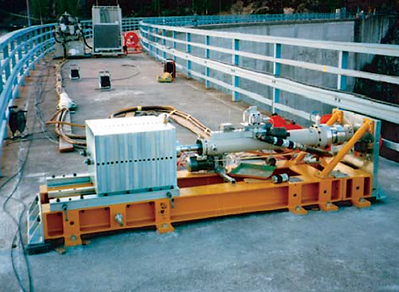Experimental Modal Analysis VS.
Operational Modal Analysis
by Ardalan Sabamehr, Ph.D.
The dynamic properties of structures can be extracted from both forced and ambient vibrations tests. The identification of the modal parameters by EMA techniques becomes more challenging in the presence of large-scale structures with low frequency ranges. Installing a controlled and measurable exciter on large scale structure (e.g. bridge, dam, etc.) is a complex and sometimes unfeasible task. To compensate for this limitation, the innovative method termed OMA (also known as an ambient vibration test) is applied to derive modal properties under the natural ambient and operational load (e.g. wind, traffic, operational load, etc.). These are therefore no longer considered as disturbances but, on the contrary, make possible the dynamic identification of large civil structures. OMA is an innovative technique and rectifies the shortcomings of traditional methods.

(a)

(b)
(a) Operational Modal Analysis using the operational load
(b) Experimental Modal Analysis using an exciter
Table comparing Experimental and Operational Modal Analyses
Experimental
Modal Analysis
Operational
Modal Analysis
Mechanical Engineering
• Artificial excitation
• Impact hammer shaker
• Controlled blast
• Well defined measured input
• Artificial excitation
• Scratching device
• Air flow
• Acoustic emissions
• Unknown signal
• Random in time and space
Civil
Engineering
• Artificial excitation
• Hydraulic shaker
• Drop weights
• Pull back tests
• Eccentric shakers and exciters
• Well-defined measured, or
un-measured input
• Controlled Blasts
• Natural Excitation
• Wind
• Waves
• Traffic
• Unknown signal
• Random in time and space
with some spatial correlation
Over the years, OMA has gradually developed as an autonomous technique even though most OMA methods have been derived from EMA procedures, meaning they share a common theoretical background with input–output procedures. The main difference between OMA and EMA is in the type of the input, which is a known force in EMA and a random process in OMA. Therefore, while EMA procedures are developed in a deterministic framework, OMA methods can be seen as their stochastic counterpart.
Nowadays, due to advancement in vibration sensors and mathematical algorithms it is possible to derive modal properties without a need for external exciters and only based on measuring the response of a structure in ambient condition. Ambient vibration test can be done with few wireless vibration sensors only in 1 day with no interruption at all on the building operation. This test will provide accurate mode shapes, natural frequencies and estimation of damping ratios.
ALL RIGHTS RESERVED
Copyright © 2022




